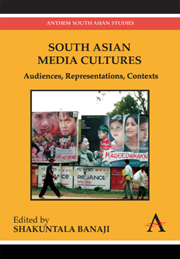Book contents
- Frontmatter
- Contents
- List of Illustrations
- 1 Introduction
- Part One Elaborating Audiences: Meaning, Use and Social Context
- 2 Talking Back to ‘Bollywood’: Hindi Commercial Cinema in North-East India
- 3 ‘Adverts Make Me Want to Break the Television’: Indian Children and their Audiovisual Media Environment in Three Contrasting Locations
- 4 Urdu for Image: Understanding Bangladeshi Cinema through its Theatres
- 5 Musical Media and Cosmopolitanisms in Nepal's Popular Music, 1950–2006
- Part Two Telling Texts: Media Discourse, Identity and Politics
- Part Three Alternative Producers: The Articulation of (New) Media, Politics and Civic Participation
- List of Contributors
4 - Urdu for Image: Understanding Bangladeshi Cinema through its Theatres
from Part One - Elaborating Audiences: Meaning, Use and Social Context
Published online by Cambridge University Press: 05 March 2012
- Frontmatter
- Contents
- List of Illustrations
- 1 Introduction
- Part One Elaborating Audiences: Meaning, Use and Social Context
- 2 Talking Back to ‘Bollywood’: Hindi Commercial Cinema in North-East India
- 3 ‘Adverts Make Me Want to Break the Television’: Indian Children and their Audiovisual Media Environment in Three Contrasting Locations
- 4 Urdu for Image: Understanding Bangladeshi Cinema through its Theatres
- 5 Musical Media and Cosmopolitanisms in Nepal's Popular Music, 1950–2006
- Part Two Telling Texts: Media Discourse, Identity and Politics
- Part Three Alternative Producers: The Articulation of (New) Media, Politics and Civic Participation
- List of Contributors
Summary
Introduction
‘Tasveer is an Urdu word,’ said Aziz, the assistant manager at Tosbir Mohol cinema hall. He explained the unfamiliar word that gave the theatre its name: Tosbir Mohol, or Picture Palace. It was written in bold Bengali letters, transliterating the tasveer to tosbir, over the entrance of the small cinema hall in Jessore. I had traveled to the district town to witness the screening of a Bangladeshi action film. I had been studying the production and consumption of this film, that I call Mintu the Murderer, for nearly a year. After many months of production, it was during Eid 2005 that the film was finally released. One of the theatres in which it opened was Tosbir Mohol in Jessore. For two weeks, Mintu the Murderer competed there with the offerings at the four rival Jessore cinema halls: Chitra, Nirala, Monihar, and Manushi.
In this chapter I will give an account of contemporary Bangladeshi cinema written from the perspective of the cinema halls in a single Bangladeshi city. Film studies throughout South Asia is generally deeply committed to textual studies (Raju 2006; Gazdar 1997; Gopalan 2002), so much so that the question of representation comes to overshadow questions of audience and the contexts of production and consumption (Hughes 2003). In this chapter, I approach contemporary Bangladeshi cinema through the theatres of Jessore. Ethnographic data from these halls yields new insights about contemporary Bangladeshi cinema.
- Type
- Chapter
- Information
- South Asian Media CulturesAudiences, Representations, Contexts, pp. 73 - 90Publisher: Anthem PressPrint publication year: 2010



